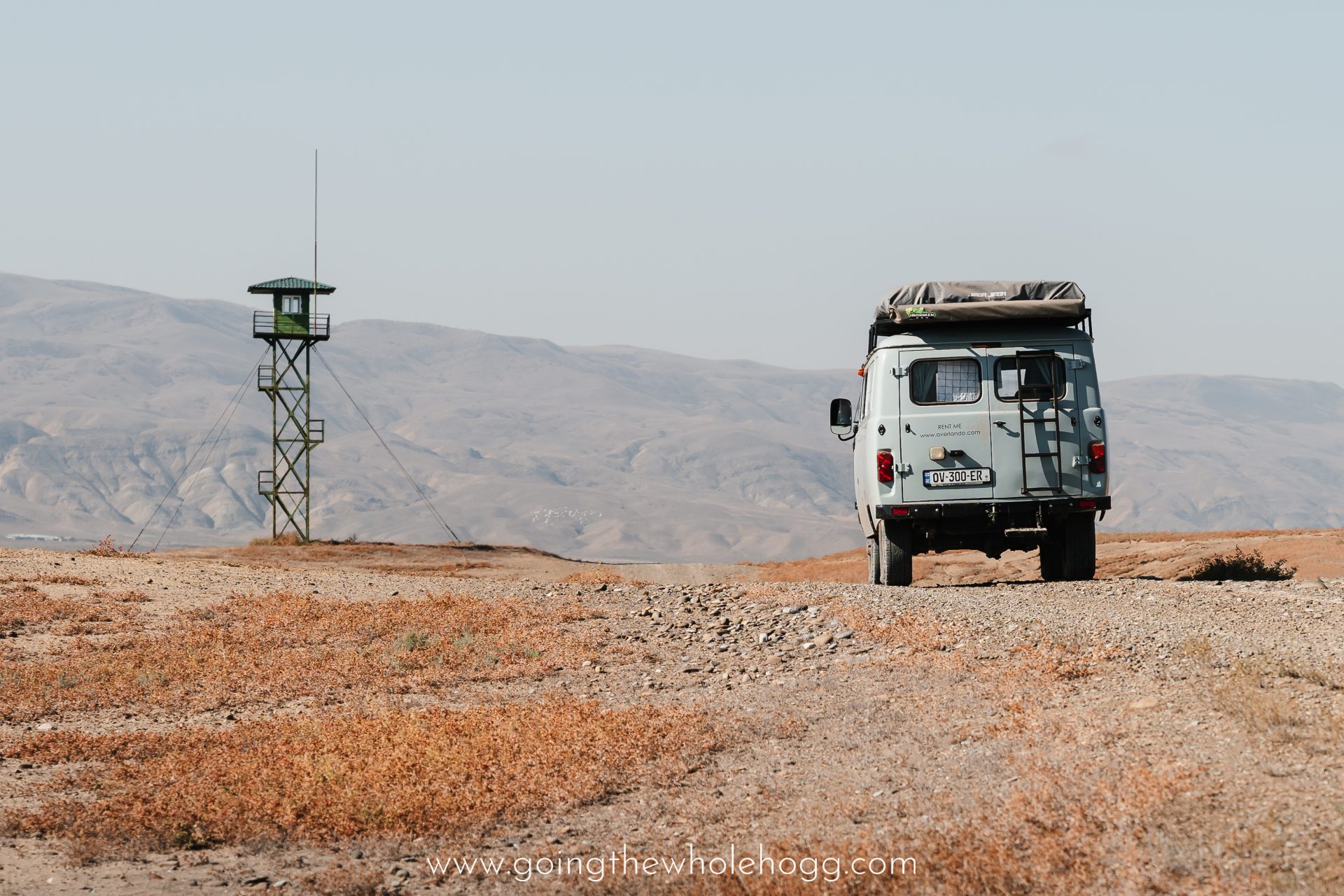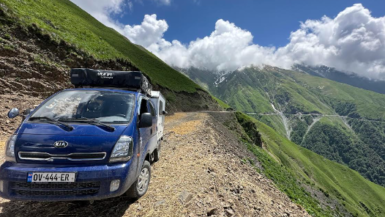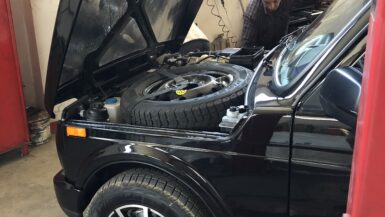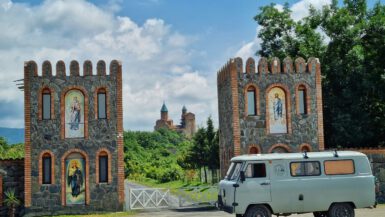Essential reading for every Overlando guest heading to Georgia’s wild southeast
Georgia’s southeast looks nothing like the snow-capped Caucasus. Near the Azerbaijan border, you’ll find cracked clay canyons, pistachio groves, bubbling mud volcanoes, and endless skies. This region, comprising Vashlovani National Park, Chachuna Managed Reserve, and the Takhti-Tepha mud volcanoes, promises adventure but can punish the unprepared. This article equips you with all the logistical and practical information for your visit.
We fully understand the allure of this region, but arriving unprepared is a recipe for trouble. Even experienced travelers may encounter issues, from minor inconveniences like flat tires to significant vehicle damage. Driving cautiously helps, but it’s impossible to eliminate all risks. Expect that if you get stuck or break down, it may take many hours or even days before help can arrive. If you’re uncomfortable with these risks, consider a guided tour led by experienced locals in their own vehicle. Guesthouses in Dedoplitskaro can arrange this for you.
When to Go – Why “After Rain” Is a No-Go
Vashlovani is open year-round, but its roads are clay-based and quickly become impassable after rain, even for fully equipped vehicles. Ideally, wait for at least two consecutive dry days before visiting. The shoulder seasons, April to May and September to October, offer mild temperatures and dry tracks. Summer is typically very hot and dry, while winter is much colder yet generally snow-free.
The scenery in spring is greener and more vivid, while summer landscapes are drier and sandy. Check the Kakheti weather forecast carefully; even brief but heavy rainfall can strand vehicles until the mud dries again.
Consider this journey as slow travel and allow at least two or three full days, but more time is even better. Driving here can be tiring due to constant steering around ruts, rocks, heat, and vibrations.
Paperwork: Permits & Border Registration
Both parks border Azerbaijan, with strict oversight by Georgian border police. The permit process is very straightforward, and all can be arranged on the spot, it takes less than an hour.
- Vashlovani Visitor Centre – Dedoplistskaro (5 Baratashvili St.)
First stop. Open weekdays 10:00–18:00 with a lunch break. Present your passport and vehicle documents, outline your intended route, and pay a small camping fee. Staff speak English and provide printed permits, maps, and updated road conditions. Inform Visitor Centre staff if visiting Chachuna or the mud volcanoes, so these areas are included in your original permit, saving an extra visit. - Border Police Station (5-minute drive from Visitor Centre)
Provide the visitor-centre paperwork. Officers will log your passport details and issue a free, stamped Border Zone Permit. Photograph this permit as a backup. - You’re free to go to the park now!
Not required, but for slightly faster processing and current road conditions, call or email the Visitor Centre (Nino) in advance: +995 577101849 – [email protected]
Logistics in Dedoplistskaro
Dedoplistskaro is your last point of civilization. Stock up thoroughly here, as there are no petrol stations, ATMs, or shops further along:
- Fuel: Diesel vehicles usually manage with a full tank, but petrol vehicles (e.g., UAZ, Lada) should carry extra fuel if doing a longer route. Off-road driving consumes significantly more fuel.
- Water: Carry ample water, as the park has only one reliable source at Mijniskure ranger station, which might not always be accessible. Bring much more than you need, in case you get stuck.
- Food: Bring more food than you anticipate needing. There is a local bazar-market with fresh produce, as well as some supermarkets and bakeries.
- Cash & Connectivity: Always carry some cash for emergencies. Mobile internet and phone coverage is patchy at best; in some areas, there is no signal at all for kilometers. If constant connectivity is essential, consider renting a Starlink satellite antenna.
- Did we mention to bring extra drinking water and food?
Road Reality: Driving on Clay, Sand, and Riverbeds
A higher-clearance 4×4 is absolutely required for both Vashlovani and Chachuna. Our campers can handle Vashlovani conditions, but cars are not invincible nor indestructible. 4×4 does not mean it can tackle every situation. Expect unpaved tracks winding through badlands, varying from firm clay to sandy patches, ruts, and deeply eroded gullies.
Familiarise yourself with the vehicle before going immediately into this raw terrain. Refer to the vehicle handbooks, check the dimensions of your vehicle. Check the angles of departure, the lowest points. Do a quick mechanical check-up before you set out.
- Tyre Pressure: Adjust tyre pressure for more comfort and better handling on sand and mud. It makes all the difference! You can refill tyres in Dedoplistskaro, where several tyre shops are available.
- Mud: Going through mud, momentum is essential, you need to keep a speed. But if you get stuck and mud cakes your tires, stop immediately. Spinning wheels only worsens the situation. Try to go back or wait until the track dries.
- Steep Terrain and Erosion: Get out of the car and walk difficult sections first. Engage low gear and differential locks (if available) before ascending or descending. Get your co-drivers to give directions from outside of the car on the tricky sections.
- Riverbeds and Crossings: Dry riverbeds hide large rocks. Drive slowly and be careful to not rip your tyres. During wet seasons, check local advice before attempting crossings; usually, alternate routes or bridges exist. Don’t cross deep or running rivers, the risks of damage to the car are too high.
- Navigation: Use offline downloaded maps (e.g., maps.me, OSMAnd) or old school paper maps. Google Maps is mostly unusable, except for the satellite view.
- Independent Thinking & Common Sense: Do not blindly follow other vehicles, GPS instructions, signs or guides. Conditions change constantly. For instance on the way to the park, Google Maps will direct you to a damaged road filled with potholes, while a smooth parallel unpaved track exists nearby. Look for recent vehicle tracks as indicators.
- Travel Companions: Traveling in pairs or small groups is ideal, so someone can get help when needed. Warn your family about being offline for a while, so they don’t worry. Going solo is possible, but you will depend on passing of other travellers, rangers and border police in case of trouble.
- Night Driving: Avoid it entirely. Tracks are almost impossible to navigate safely after dark.
- Snakes and other animals: During warm months, snakes are common. Always watch where you step, especially near bushes, rocks. Most snakes avoid humans, but caution is necessary. They might crawl into the cars engine bay. Other wildlife is usually not seen near humans. Sheepdogs can be aggressive, and follow cars, even damaging them. When walking, seek contact with the herder so he can keep the dogs in control.
Camping
Official campsites at ranger stations like Pantishara and Mijniskure offer basic amenities such as bungalows, picnic tables, fire pits, and pit toilets. You can camp in your campervan or pitch a tent. Ask a ranger if you prefer to camp a little outside the designated area, usually it isn’t a problem.
For wild camping, confirm the current rules at the Visitor Centre. Camping along the border zone is strictly prohibited, and you will be instructed to move. Further inland, wild camping is generally tolerated but may lead to nighttime visits by border patrols. Always secure your food properly to avoid nightly animal visits.
Frequently Asked Questions
Can I enter the park from the western side, without first going to Dedoplistskaro?
Theoretically, yes, but it requires significantly more preparation. You could drive from Udabno through the Iori Plain and Chachuna into Vashlovani and then back up to Dedoplistskaro. Although geographically logical from Tbilisi, this route demands arranging border permits beforehand in Tbilisi, making it considerably more time-consuming and complicated. It takes several days to process, plus time to pick up the permits in Tbilisi. Also, you will have to visit the Visitor Center in Dedoplitskaro afterwards to pay the park fees.
Can I bring my dog?
No. Dogs are not allowed in the park. Aggressive sheepdogs and the risk of snake bites make it dangerous for them. Help is non-existent if something happens.
Can I go with my motorcycle or truck?
No. Motorcycles and trucks are not allowed in the park. Vehicles between 3.5–5 tons might still be accepted, but larger trucks can’t go inside due to the small tracks.
We urge you to follow these park rules. Don’t “just try” it. The more people break the rules, the higher the risk of losing the privilege of freely and independently exploring this stunning area.
Itineraries, what to visit
This is mostly a practical guide, for more inspiration on where to go exactly, and even more preparations, we recommend the following excellent guides:
Wander Lush: Vashlovani National Park: Visitors’ Guide + Easy One Day Itinerary for the Georgian Badlands
Going the Whole Hogg: Vashlovani National Park Travel Guide
